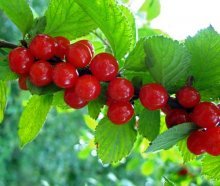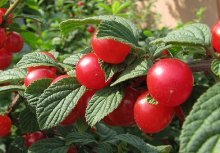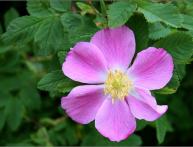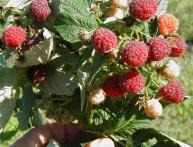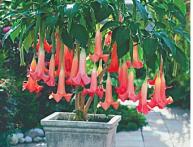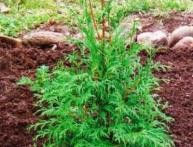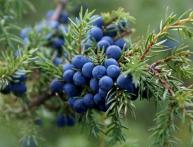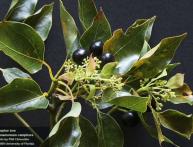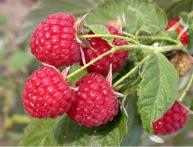Dwarf cherry and all about caring for it
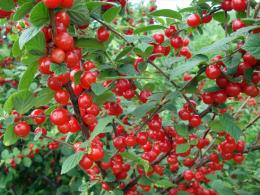
The tree is a shoot, 1-1.5 meters high with spreading branches, more like a bush. The cherry branches are thin, reddish in color, and the leaves are small (4-5 cm), slightly pointed. The bottom of the leaf is pale gray, and the top is orange or red, depending on the time of year.
Dwarf cherry blossoms for 2.5 - 3 weeks with fluffy white flowers, 2-3 flowers in a bunch. The plant is very fragrant during flowering, unlike the ordinary cherry tree. The fruit is almost black, reaching no more than 1 cm in diameter. Dwarf cherries, just like ordinary varieties, are quite edible and very healthy.
The tree loves light very much, so it needs to be planted in well-lit places; it tolerates sudden temperature changes and is resistant to frost. The soil for planting can be any. It takes root very well in areas of a densely planted garden.
Content:
- Dwarf sand cherry
- Wintering of dwarf cherries
- Propagation by seeds and planting
- Diseases of dwarf cherries
Dwarf sand cherry
Unfortunately, we know almost nothing about this type of decorative dwarf cherry. It differs from the cultivated cherry fruit tree both in appearance and in its requirements for growth, replanting and care.
The plant reaches a height of up to 1.5 meters in growth, has flexible creeping branches with unusual oblong leaves, called lanceolate among breeders.The appearance of the leaves of the dwarf sand cherry resembles a willow leaf, however, in structure it is leathery, dense, and pale green in color.
The leaf of a mature plant reaches a length of 3-5 cm, the width ranges from 1 to 2 cm. During flowering, an interesting point can be observed - depending on the soil and watering, a dwarf cherry flower can be colored either white or soft pink. . The color is collected in bunches of 4-6 flowers, forming beautiful decorative bouquets up to 12 cm in diameter.
Dwarf cherry at home
A variety of dwarf cherry for planting in an apartment is Cuban cherry. This plant is planted in a large pot and placed in a place illuminated by sunlight. The tree needs stable, regular watering and fertilizing in the spring. At home, cherries can also bloom and bear fruit, and there is no big difference between caring for this plant in the garden and in the apartment.
Also, depending on the degree tree care, during ripening, you can observe different colors in the fruits. Cherries are oval or round, 2x2cm, and can be pale pink and purple and dark red, almost black. The taste of sand cherry is very similar to bird cherry - the fruits are astringent and slightly tart, so when growing a tree you should be prepared that you may not like the taste of cherries.
Dwarf sand cherries ripen from mid-August to mid-September. In the southern regions, fruits ripen faster - 10-15 days, in the middle zone - up to 20-25. It is interesting that this variety of dwarf cherry was recognized in nature as a wild plant and was brought to us from North America.
It is there that the tree grows on the sandy banks of mountain rivers.This plant was first cultivated by the American Charles Bessey, who saw an excellent ornamental plant in this small shrub.
Amazing beauty is given to the plant not only by the flower buds, but also by the leaves, which gradually turn yellow, orange, and then red in autumn, gradually falling off. Sometimes a wonderful sight can be observed during the early cold period, when the leaves fall, leaving ripe red fruits on the branches. Gardeners note that if the harvest is not harvested during this period, in winter the taste of the dried berries will be extraordinary.
Wintering of dwarf cherries
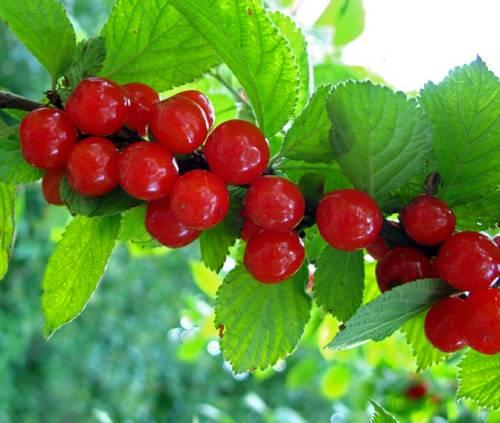
In winter, try not to replant dwarf cherries, if they grow in the garden. The plant tolerates low temperatures quite steadfastly, the root system can withstand frosts on the soil down to -400C, and the tree itself easily tolerates air temperatures of -30-35 degrees C.
To prepare the tree for wintering The following standard procedures should be in place:
- Pruning
- Cleaning dried old bark
- Cleaning the crown of wilted leaves
- Disinfection and soaking of wounds with appropriate solutions
- Burning old leaves and fallen branches
Propagation by seeds and planting
Plant reproduces and transplants seeds. In order to plant cherry seedlings in the spring, the seeds must be kept for 2-3 months, the first month at a temperature of 16-180C, and the remaining time in the refrigerator. 3-5 days before sowing, the seeds must be removed, allowing them to rest and adapt at room temperature.
In addition, it should be noted that the seeds must be kept in a moist environment at all times. It is necessary to provide them with at least 55-60% humidity.
However, planting dwarf cherries in early spring should be done away from water bodies and sources, since the root system of the plant does not absorb large amounts of moisture.
Cuttings
Dwarf cherries can also be propagated by cuttings or horizontal and vertical layering. The plant does not live in the garden for more than 10 years, so at 7-8 years of age you need to take care of planting it.
Seedlings produce flowers and buds only in the second year of their life, and by the next year they bring a small first harvest. The tree bears fruit regularly, gaining high levels by the 5-6th year of life - up to 10-12 kg. However, it is worth noting that the bush will produce fruit only when pollinated with nearby dwarf cherries, so it is recommended to plant at least 3-4 pieces in the garden.
Diseases of dwarf cherries

The most unpleasant and dangerous of diseases for this ornamental tree is monoliosis (monolial burn). As soon as the plant fades, the leaves on the bush begin to wither or curl, then fall off very quickly, sometimes without even having time to dry, in rare cases remaining hanging on the stems of the bush in an affected form.
In order to prevent complete damage to the tree, as soon as the disease is detected, it is necessary to urgently cut and burn the damaged areas of the branches, clearly limiting and protecting healthy ones from them, leaving a gap of 8-10 cm between the affected part.
In the spring, a tree that has recovered from the disease before the beginning of primrose is treated with preparations containing a certain percentage of copper or beard fluid (3%). The liquid must contain copper sulfate and lime. Cherries are sprayed 4-5 times every two weeks.
Prevents and warns unwanted diseases feeding the dwarf tree with mineral and organic fertilizers. They necessarily contain microelements such as manganese, zinc, potassium, and boron. However, if all efforts are in vain and the disease has gone too far, the dwarf cherry tree must be dug up by the roots.
The tree must be burned to prevent the disease from spreading and damaging the entire garden. Every experienced gardener will tell you that problems and diseases noticed in time are solved faster and easier than neglected ones.
Educational video about felt cherry:
Interesting information about the vegetable garden

